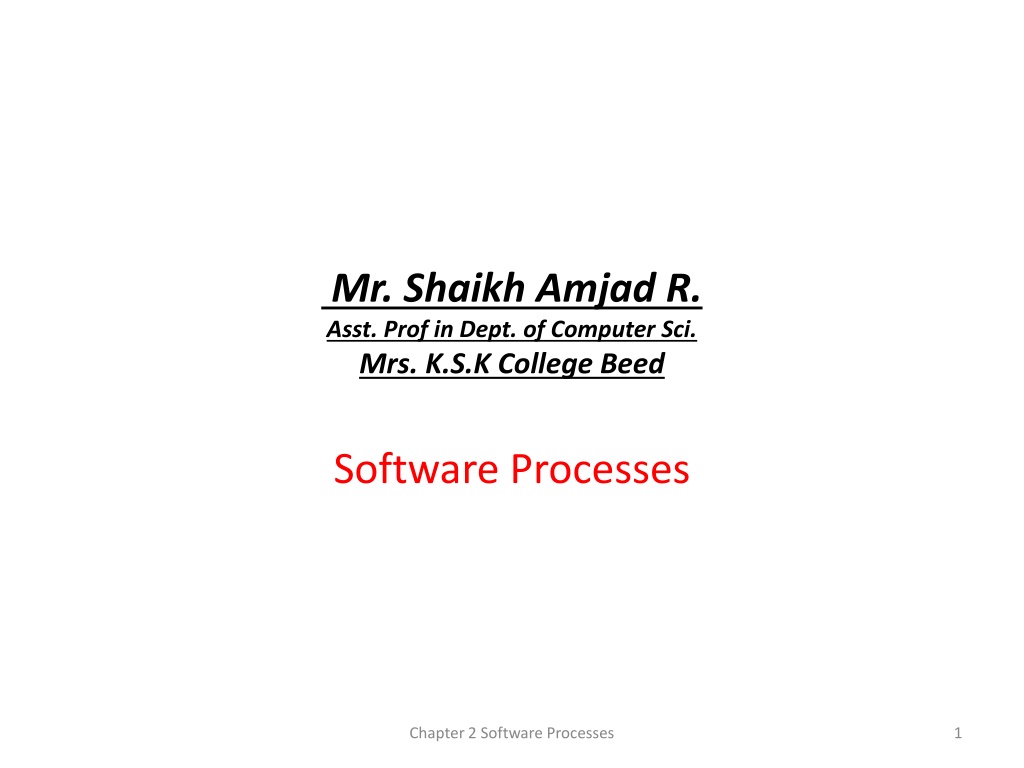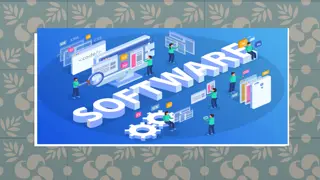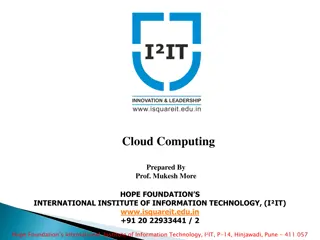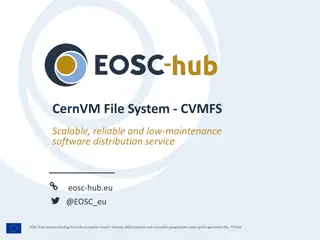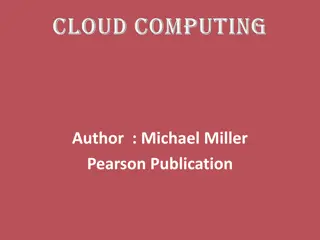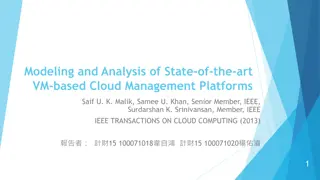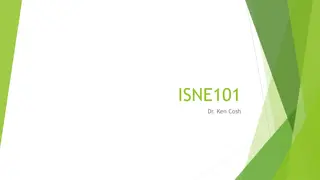Understanding Software Processes in Modern Computing
Explore the structured activities involved in software development, from specification to validation and evolution. Discover different software process models like the waterfall model and incremental development. Learn about process descriptions, roles, phases, and the challenges of accommodating change in the development lifecycle.
Download Presentation

Please find below an Image/Link to download the presentation.
The content on the website is provided AS IS for your information and personal use only. It may not be sold, licensed, or shared on other websites without obtaining consent from the author. Download presentation by click this link. If you encounter any issues during the download, it is possible that the publisher has removed the file from their server.
E N D
Presentation Transcript
Mr. Shaikh Amjad R. Asst. Prof in Dept. of Computer Sci. Mrs. K.S.K College Beed Software Processes Chapter 2 Software Processes 1
Topics covered Software process models Process activities Coping with change The Rational Unified Process An example of a modern software process. Chapter 2 Software Processes 2
The software process A structured set of activities required to develop a software system. Many different software processes but all involve: Specification defining what the system should do; Design and implementation defining the organization of the system and implementing the system; Validation checking that it does what the customer wants; Evolution changing the system in response to changing customer needs. A software process model is an abstract representation of a process. It presents a description of a process from some particular perspective. Chapter 2 Software Processes 3
Software process descriptions When we describe and discuss processes, we usually talk about the activities in these processes such as specifying a data model, designing a user interface, etc. and the ordering of these activities. Process descriptions may also include: Products, which are the outcomes of a process activity; Roles, which reflect the responsibilities of the people involved in the process; Pre- and post-conditions, which are statements that are true before and after a process activity has been enacted or a product produced. Chapter 2 Software Processes 4
Software process models The waterfall model Plan-driven model. Separate and distinct phases of specification and development. Incremental development Specification, development and validation are interleaved. May be plan-driven or agile. Reuse-oriented software engineering The system is assembled from existing components. May be plan-driven or agile. In practice, most large systems are developed using a process that incorporates elements from all of these models. Chapter 2 Software Processes 5
The waterfall model Chapter 2 Software Processes 6
Waterfall model phases There are separate identified phases in the waterfall model: Requirements analysis and definition System and software design Implementation and unit testing Integration and system testing Operation and maintenance The main drawback of the waterfall model is the difficulty of accommodating change after the process is underway. In principle, a phase has to be complete before moving onto the next phase. Chapter 2 Software Processes 7
Waterfall model problems Inflexible partitioning of the project into distinct stages makes it difficult to respond to changing customer requirements. Therefore, this model is only appropriate when the requirements are well-understood and changes will be fairly limited during the design process. Few business systems have stable requirements. The waterfall model is mostly used for large systems engineering projects where a system is developed at several sites. In those circumstances, the plan-driven nature of the waterfall model helps coordinate the work. Chapter 2 Software Processes 8
Incremental development Chapter 2 Software Processes 9
Incremental development benefits The cost of accommodating changing customer requirements is reduced. The amount of analysis and documentation that has to be redone is much less than is required with the waterfall model. It is easier to get customer feedback on the development work that has been done. Customers can comment on demonstrations of the software and see how much has been implemented. More rapid delivery and deployment of useful software to the customer is possible. Customers are able to use and gain value from the software earlier than is possible with a waterfall process. Chapter 2 Software Processes 10
Incremental development problems The process is not visible. Managers need regular deliverables to measure progress. If systems are developed quickly, it is not cost-effective to produce documents that reflect every version of the system. System structure tends to degrade as new increments are added. Unless time and money is spent on refactoring to improve the software, regular change tends to corrupt its structure. Incorporating further software changes becomes increasingly difficult and costly. Chapter 2 Software Processes 11
Software specification The process of establishing what services are required and the constraints on the system s operation and development. Requirements engineering process Feasibility study Is it technically and financially feasible to build the system? Requirements elicitation and analysis What do the system stakeholders require or expect from the system? Requirements specification Defining the requirements in detail Requirements validation Checking the validity of the requirements Chapter 2 Software Processes 12
The requirements engineering process Chapter 2 Software Processes 13
Software design and implementation The process of converting the system specification into an executable system. Software design Design a software structure that realises the specification; Implementation Translate this structure into an executable program; The activities of design and implementation are closely related and may be inter-leaved. Chapter 2 Software Processes 14
Software prototyping A prototype is an initial version of a system used to demonstrate concepts and try out design options. A prototype can be used in: The requirements engineering process to help with requirements elicitation and validation; In design processes to explore options and develop a UI design; In the testing process to run back-to-back tests. Chapter 2 Software Processes 15
Benefits of prototyping Improved system usability. A closer match to users real needs. Improved design quality. Improved maintainability. Reduced development effort. Chapter 2 Software Processes 16
The process of prototype development Chapter 2 Software Processes 17
Prototype development May be based on rapid prototyping languages or tools May involve leaving out functionality Prototype should focus on areas of the product that are not well-understood; Error checking and recovery may not be included in the prototype; Focus on functional rather than non-functional requirements such as reliability and security Chapter 2 Software Processes 18
Incremental delivery Rather than deliver the system as a single delivery, the development and delivery is broken down into increments with each increment delivering part of the required functionality. User requirements are prioritised and the highest priority requirements are included in early increments. Once the development of an increment is started, the requirements are frozen though requirements for later increments can continue to evolve. Chapter 2 Software Processes 19
Incremental development and delivery Incremental development Develop the system in increments and evaluate each increment before proceeding to the development of the next increment; Normal approach used in agile methods; Evaluation done by user/customer proxy. Incremental delivery Deploy an increment for use by end-users; More realistic evaluation about practical use of software; Difficult to implement for replacement systems as increments have less functionality than the system being replaced. Chapter 2 Software Processes 20
Incremental delivery Chapter 2 Software Processes 21
Boehms spiral model of the software process Chapter 2 Software Processes 22
Spiral model sectors Objective setting Specific objectives for the phase are identified. Risk assessment and reduction Risks are assessed and activities put in place to reduce the key risks. Development and validation A development model for the system is chosen which can be any of the generic models. Planning The project is reviewed and the next phase of the spiral is planned. Chapter 2 Software Processes 23
Spiral model usage Spiral model has been very influential in helping people think about iteration in software processes and introducing the risk- driven approach to development. In practice, however, the model is rarely used as published for practical software development. Chapter 2 Software Processes 24
